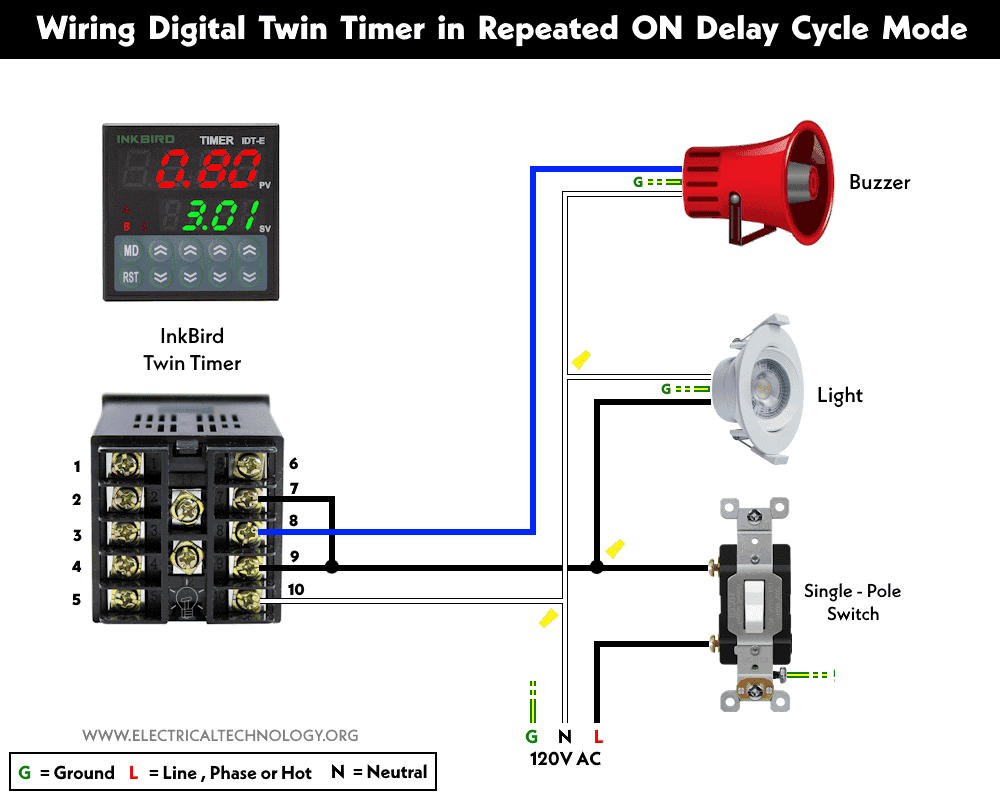How to Wire Twin Timer for Repeated ON-Delay in Cycle Mode?
Wiring Digital Twin Timer in Repeated ON Delay Cycle Mode
In our previous wiring tutorial, we discussed how to wire a one-shot timer using a twin timer for delay. In today’s post, we will demonstrate how to wire the same digital timer for repeated cycle operation.
The twin timer can be used in two modes: one-shot operation or repeated operation viz.
One-Shot Mode:
In one-shot operation, when the predefined time setting expires, the connected load will be either ON or OFF permanently (based on OFF-delay or ON-delay circuit design). It means only a single operation is offered by the timer. For the second operation, the timer will have to be reset to the initial stage by turning off the power supply to the timer or momentarily connecting terminal 3 (RESET) and 4 (+12V).
Repeated Cycle Mode:
In the repeated cycle, as the name suggests, the ON and OFF operation of the circuit can be repeated, offering multiple operations instead of a one-shot operation, as mentioned above.
Related Posts:
- How to Wire Twin Timer for 120V/240V Circuits – ON/OFF Delay
- Wire Twin Timer in Repeat Cycle & One-Shot Mode for 120V/240V Motors?
Suppose you need to design a circuit based on a digital twin timer for the following operations:
- An 120V AC light bulb is controlled by a single-pole (2-way) switch.
- When the light is ON by a two-way switch, the buzzer should sound after 10 minutes. The light remains ON.
- After buzzing, the buzzer should turn OFF after 20 seconds. The light remains ON.
- The circuit should automatically repeat, i.e., the buzzer buzzes after 10 mins and turns off after 20 sec.
To do so,
- Set the timer in hours mode for both Time A and Time B.
- Set Time A for 00:10.
- Set Time B for 00:02.
Related Posts:
- How to Wire One-Shot Timer using Twin Timer For Delay?
- How to Wire Twin Timer with Photo Eye Circuit for Time Delay?
Working of the Twin Timer For Repeated ON-Delay Operation
- When the operator switches ON the circuit using a single-pole switch, it will turn on the light bulb (and remains ON until the two-way switch is switched OFF).
- The digital twin timer is activated, and the delay begins for 10 mins.
- When the delay period expires, the buzzer circuit activates and sounds for 20 sec.
- The second delay expires after 20 sec, and the buzzer turns off.
- As it is a repeated cycle circuit, the first delay time period starts again.
- The repeated cycle (in sequence) continues until the single-pole switch for the light is turned off. If so, the timer circuits reset to the initial state.
While wiring and configuring the circuit for repeated cycle operation using a twin timer, consider the following:
- The twin timer can be set up for one-shot or repeated cycles operations in both 120V and 240V circuits.
- Maximum 10A circuit can be wired for OFF-delay operation using twin timer.
- The twin timer can be set-up from 0.9 sec to 99 hrs.
- Never ever connect the power supply to terminals 1 to 5 of the twin timer.
Related Posts:
- How to Toggle between Two Heat Pumps using 240V Twin Timer?
- How to Toggle Electric Water Heater Between 120V and 240V?
- How to Control 120V & 240V Water Heater using ST01 Timer and Contactors?
- How to Wire ST01 Timer with Relay & Contactor for 120V/240V Motors?
- How to Reduce Runtime of Air-Conditioner During Peak Hours?
- How to Wire Multifunction ON/OFF Delay Timer for 120V/240V Motors?
- How to Wire ON-Delay Timer for 120V and 240V Load Circuits?
- How to Wire OFF-Delay Timer for 120V and 240V Load Circuits?
- Difference Between ON Delay and OFF Delay Timer
- How to Wire ON/OFF Delay Timer for AC & DC Loads – 230V & 24VDC
- Automatic & Manual Control of 3-Phase Motor Using Delay Timer
- Automatic ON/OFF Circuit Using Two 8-PIN Timers for 1 & 3-Φ Load
- How to Wire AH3 OFF-Delay Timer and Relay with Boiler Fan?
- How to Reverse Operation of Photo Eye using ST01 Timer?
- How to Wire ST01 Timer for Dusk-Dawn On-Delay Light Control?
- How to Wire Spring Wound Timer with LYS Rely for ON/OFF Delay
- How to Wire Remote Control Countdown Timer?







